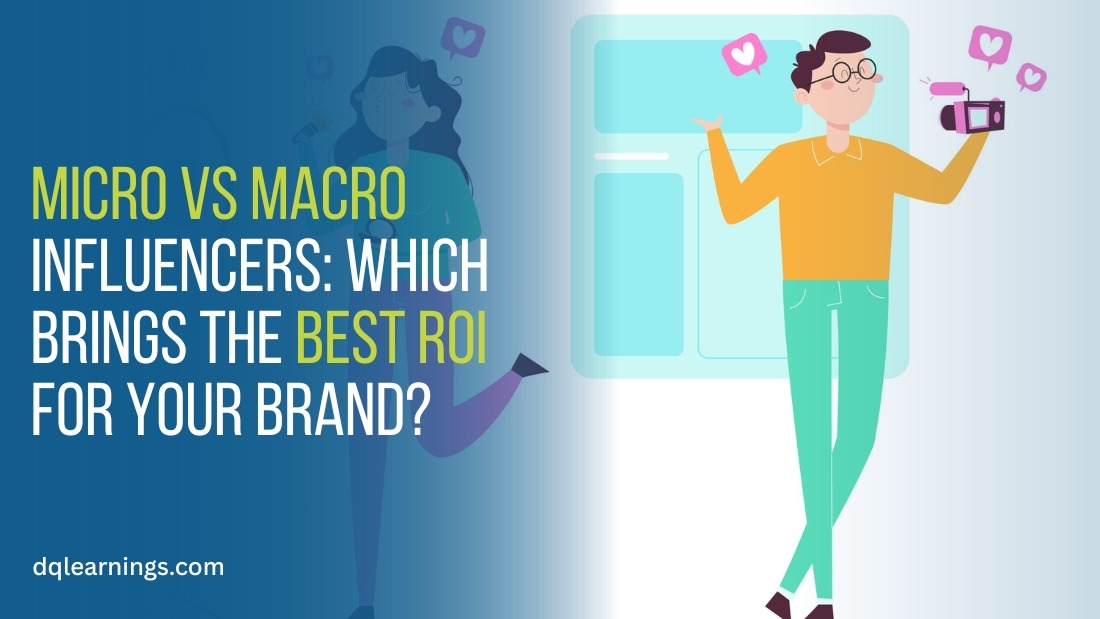Influencer marketing is a force to be reckoned with in the digital world, but influencers are not all alike. Among the most contentious issues in this arena is micro vs macro influencers. They both have their strengths, but when it is all about ROI (Return on Investment), which one actually offers your brand the biggest bang for its buck?
Let's go deep into influencer marketing and discover in which category micro or macro influencers there is more ROI, engagement, trust, and scalability for your business.
Micro and Macro Influencers: What Are They?
Before comparing, it's crucial to know who we are referring to.
- Micro Influencers: 10,000 to 100,000 followers. Serve niche audiences with highly engaged communities.
- Macro Influencers: 100,000 to 1 million+ followers. Often celebrities or known figures with broad reach.
The Power of Micro Influencers: Authenticity and Engagement
When it comes to real connection, micro influencers take the top spot. These creators tend to specialize in one niche like fitness, fashion, gaming, beauty, or parenting, and their fans consider them close friends.
Advantages of Micro Influencers:
- Higher Engagement Rates: Up to 60% more engagement than macro influencers.
- Lower Cost Per Post: Affordable collaboration, allowing more influencer partnerships.
- Focused Audiences: Ideal targeting due to niche followings.
- More Trust & Authenticity: Personal interactions foster trust.
The Reach of Macro Influencers: Visibility and Brand Awareness
Macro influencers come with undeniable power: massive reach. If your goal is to create instant awareness or dominate a large audience fast, macro influencers can make that happen.
Advantages of Macro Influencers:
- Broader Reach: Reach hundreds of thousands to millions of users.
- Quick Credibility: Partnering with celebrities boosts brand status.
- Expert Content Creation: High-quality production and visuals.
Limitations of Macro Influencers:
- Lower Engagement: Less interaction with audiences.
- Higher Cost: Posts may cost thousands to hundreds of thousands.
- Less Targeting Precision: Broader audiences may dilute targeting.
Engagement vs Exposure: Which Matters More?
This depends on your goals:
- Conversions, trust, loyalty: Go micro.
- Brand awareness, reach: Go macro.
Comparison Table:
| Feature |
Micro Influencers |
Macro Influencers |
| Followers Range |
10K – 100K |
100K – 1M+ |
| Engagement Rate |
High (4–8%) |
Medium to Low (1–3%) |
| Cost per Post |
Low to Moderate |
High |
| Audience Type |
Niche-focused |
Broad/general |
| Content Authenticity |
Very High |
Moderate |
| Conversion Potential |
High |
Moderate to Low |
| Ideal For |
Conversions, product trials |
Brand awareness, PR |
Cost Efficiency and ROI: The Numbers Don't Lie
Micro influencers offer greater value per dollar. Their deep engagement typically drives more sales or conversions.
- Micro Influencer Cost: 1000 INR - 20,000 INR per post
- Macro Influencer Cost: 20,000 INR - 50,000 INR per post
Now imagine you have a ₹50,000 budget:
- With micro influencers, you can collaborate with 10–20 creators across various niches - allowing you to test, refine, and diversify audience reach.
- With a macro influencer, you might afford just one post - with no guarantee of actual conversions or sales.
Micro influencers also allow for scalable, performance-driven campaigns. You can easily track what works, double down on top performers, and optimize for better ROI something that's much harder with a one-shot macro campaign.
Scalability and Campaign Flexibility
Micro influencers are highly scalable and adaptable. Brands can:
- Run A/B tests with different creatives
- Launch localized campaigns in specific regions
- Ensure diverse representation aligning with DEI goals
Pro Tip: Brands using micro clusters before macro launches saw 32% better ROI due to refined messaging.
Measuring ROI: Micro vs Macro Influencers
Key Metrics:
- Engagement Rate
- Click-Through Rate (CTR)
- Conversion Rate
- CPM & CPC
- Customer Acquisition Cost (CAC)
Average Results:
| Measure |
Micro Influencers |
Macro Influencers |
| Engagement Rate |
6%–10% |
1%–2% |
| CTR |
2.5% |
0.7% |
| Conversion Rate |
3.5%–6% |
1%–2% |
| CPM |
Lower |
Higher |
| Trust & Sentiment |
High |
Moderate |
Hybrid Approach: The Best of Both Worlds
A hybrid strategy can offer reach and conversion at once:
- Use macro influencers for buzz and visibility.
- Use micro influencers for conversions and engagement.
- Refine messaging using micro performance data.
Example: A global soft drink company used a macro celebrity for awareness, followed by 100+ micro influencers in fitness. Result: 14% boost in trial purchases and 40% increase in social buzz within 30 days.
Which One Should You Choose?
Choose Micro Influencers If:
- High engagement and conversions are the goal
- You’re on a limited budget
- You’re promoting niche products
- You want authenticity and trust
Choose Macro Influencers If:
- You want massive brand awareness
- You’re launching globally
- You need celebrity recognition
- Budget is flexible
Conclusion
In the micro vs macro influencer debate, your goals will determine the winner. For ROI, conversions, and trust, micro influencers win. For visibility and reach, macro influencers shine. Smart brands test, analyze, and adapt for best results.
FAQs
- 1. Are micro influencers better than macro influencers?
- Yes, especially for engagement and ROI due to their niche and trusted audience.
- 2. What's the cost of hiring a micro influencer?
- Usually $100–$500 depending on niche and engagement.
- 3. Can I use micro and macro influencers together?
- Absolutely. A hybrid campaign works well for reach + conversion.
- 4. How do I calculate influencer marketing ROI?
- Track CTR, engagement, conversions, CAC, and sentiment.
- 5. Is follower count the most important metric?
- No. Engagement and audience trust are more impactful than just follower count.
